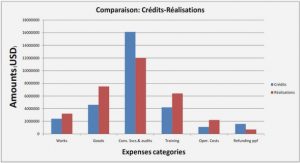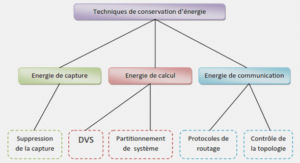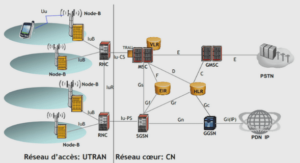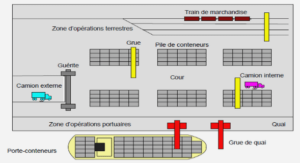A classification of the different approaches that can be adopted to manage the OFDMA subchannels in a macro-femtocell network are schematized , which is a modified version of the original classification given in (Lopez-Perez et al., 2009).
To completely eliminate the cross-tier interference, an approach that divides the licensed spectrum into two dedicated parts is proposed in (Chandrasekhar and Andrews, 2008). This approach is known as spectrum partitioning approach. In this way, a fraction of the subcarriers would be used by the macro tier while another fraction would be used by the femtocells However, this approach is inefficient in terms of spectrum reuse. In fact, the main concerns of this type of approaches are the efficient power distribution over the active DL transmissions per BS and the prioritization of the macro communications over femto communications .
Co-channel allocation for both tiers seems to be more efficient and profitable from operators’ perspective, although more challenging from the technical point of view. This means that the whole license spectrum can be simultaneously used among the tiers ,(Kang et al., 2012). This approach is also known as spectrum sharing and is recommended for dense FC deployment but it requires interference management schemes to uphold Quality of Service (QoS) of downlink (DL) or uplink (UL) communications and to improve the spectrum efficiency.
Hybrid spectrum usage approaches combine the spectrum sharing and spectrum partitioning approaches depending on the FC location. Some examples of hybrid spectrum usage are:
• Fractional Frequency Reuse (FFR) divides the entire frequency spectrum into several subbands, which are differently assigned to each macrocell or femtocells located in a subarea of the macrocell in such a way that the resources for femtocell are not overlapped with the overlaid macrocell resource (Lee et al., 2010b).
• Dynamic or Adaptive FFR determines the frequency reuse for femtocells coupled with pilot sensing to reduce cross-tier/co-tier interference between macrocell and femtocells. The macrocell uses a frequency reuse factor of three or above and each femtocell sense the pilot signals from the macrocell and discard the sub-band with the largest received signal power, and thus FCs use the rest of the frequency sub-bands resulting in an increased SINR for macro UEs. The overall network throughput is enhanced by adopting high order modulation schemes (Kim and Jeon, 2012).
• Soft frequency reuse (SFR) divides also the system bandwidth into sub-bands. The frequency bands are assigned to FCs using a soft frequency reuse technique in inner regions of multiple macrocells. The distance to the boundary of the MC inner region is adaptively determined to the achieve the required demand of the cell-edge user (Li et al., 2012a).
One important concern of a RA approach for OFMDA macro-femtocell networks is its complexity, which can be categorized into two types: (1) computational complexity and (2) implementation complexity. The computational complexity of an RA algorithm refers to the processing time required to execute the algorithms at the BS. On the other hand, the implementation complexity refers to the amount of signaling overhead and information exchange between BSs (Lee et al., 2014). As dense FC deployment is expected in wireless networks in the near future, traditional RA approaches may not be feasible due to excessive signaling overhead between BSs. Moreover, the computational time of an RA algorithm should be kept within a resource block period, since resource allocation among UEs is performed for every TTI in the OFMDA systems (Yang, 2010).
In the following, we provide a detailed analysis for the related work in the literature that intersects with the addressed problems, and the proposed methodology.
Linear Programming based Resource Allocation models
In this section, we present the related work using linear programming found in the literature. The optimal distance for the inner region of macrocell using fractional frequency reuse RA approach was deduced in (Assaad, 2008). In this scheme, fixed transmitted power per macrocell and femtocell is assumed. However, this scheme solve the resource allocation for an environment with multi-macrocells, where the neighboring macrocell are restricted to use only a sub-band of the whole licensed spectrum which means a reduction of spectrum reuse for multicell environments. In (Le et al., 2012), a joint load balancing and admission control scheme for OFDMA Based Femtocell Networks is presented. In their work, the admission control problem is formulated based on a Semi-Markov Decision Process (SMDP) and a Linear Programming (LP) solution is proposed to address the minimization of the blocking probability to obtain the optimal admission control policy and the traffic load for each femtocell. Then, a power adaptation algorithm is applied in each FC to reduce the co tier interference achieving better femtocell throughput and more energy-efficient operation of the femtocell considering the variety of traffic load in the femtocell network. The authors claim that efficient admission control policy is needed to coordinate spectrum sharing and admission control decisions for both types of users (public users and subscribers), which should find a trade-off between achieving high spectrum utilization and protecting QoS subscriber requirements. However, the main disadvantages of this scheme are the lack of the motivation for FC to grant access to public users, the power adaptation is not performed together with the bandwidth allocation in the femtocell network, and the BS re-selection procedure is not established for the case when public users are blocked by the femtocell network.
A hierarchical three-stage RA solution is presented by (Sadr and Adve, 2012) that consists of: (1) the load of each FC is estimated considering the number of connected users, their average channel gain and required data rates; (2) the physical resource blocks (PRBs) are allocated to FCs taking into account each FC load in such a way that minimizes the interference by coloring the modified interference graph; and (3) the resource allocation is formulated as a convex maxmin fair optimization problem. This optimization problem is converted to linear program by using a simplified alternative that equally distributes the total FC transmitted power among the channels. However, equal power distribution among the channels converts the problem into the bandwidth optimization problem.
Subcarrier/Subchannel allocation has been investigated with several objective functions for OFDMA macro-femtocell network under the assumption of equal power distribution per bandwidth unit. For example, the work in (Hatoum et al., 2011) solves the subchannel allocation within a cluster using Linear Programming for a given cluster configuration using equal power distribution among the DL channels.
|
Table des matières
INTRODUCTION
CHAPTER 1 LITERATURE REVIEW
1.1 Optimization Tools
1.1.1 Linear Programming
1.1.2 Evolutionary Optimization Methods
1.1.2.1 Genetic Algorithm (GA)
1.1.2.2 Particle swarm optimization (PSO)
1.2 OFDMA Technology Overview
1.3 Femtocell Overview
1.3.1 Access Control Policies
1.3.2 Hybrid Access Femtocells
1.4 Resource Allocation for OFDMA system
1.5 Resource Allocation for OFDMA Macro-femtocell Networks
1.5.1 Linear Programming based Resource Allocation models
1.5.2 Resource Allocation models using alternative optimization tools
1.5.3 Cluster based Resource Allocation Algorithm
CHAPTER 2 BASE STATION SELECTION AND RESOURCE ALLOCATION
IN MACRO-FEMTOCELL NETWORKS UNDER NOISY
SCENARIO
2.1 Abstract
2.2 Introduction
2.3 Problem Statement
2.4 Base Station Selection and Resource Allocation Model (BSS-RAM)
2.4.1 ILP Formulation
2.4.1.1 Model Parameters
2.4.1.2 Model Variables
2.4.1.3 Objective Function
2.4.1.4 Model Constraints
2.4.2 Linear Approximation of Log Term
2.4.3 Conversion of real variable to binary variable
2.4.4 Weights applied in RA models
2.4.4.1 Link Rate
2.4.4.2 Demand
2.4.5 Benchmark Model
2.5 Performance Measurements
2.6 Simulation Results
2.6.1 Simulation Scenario
2.6.2 Impact of Signal to Noise Ratio
2.6.2.1 Throughput and Power Usage
2.6.2.2 Impact of Noise
2.6.3 Impact of users density in FC neighborhood
2.6.4 User Satisfaction and Maximum Transmitted Power Required in
MC
2.6.5 Maximum Transmitted Power Required in MC vs number of
mobile users
2.6.6 Throughput MSE
2.6.7 Complexity
2.7 Conclusion
CHAPTER 3 ENERGY-EFFICIENT RESOURCE ALLOCATION MODEL
FOR OFDMA MACRO-FEMTOCELL NETWORKS
3.1 Abstract
3.2 Introduction
3.3 Problem Statement
3.3.1 Interference perceived in Femto Tier
3.3.2 Interference perceived in Macro Tier
3.4 Controlled per subcarrier Model (Controlled-SC)
3.4.1 Problem Formulation
3.4.2 LP Parameters
3.4.3 Model Variables
3.4.4 Objective Function
3.4.5 Model Constraints
3.4.6 Linear Approximation of Log Term
3.5 Benchmark Resource Allocation models
3.5.1 Underlay Model
3.5.2 Controlled-underlay model
3.5.3 Orthogonal Resource Allocation model(O-RAM)
3.6 Performance Measurements
3.7 Simulation Results
3.7.1 Simulation Scenarios
3.7.2 Throughput, Bandwidth and Power Usage
3.7.3 Blocking Ratio and User Satisfaction
3.7.4 Complexity
3.8 Conclusion
CHAPTER 4 SPECTRUM SHARING MODEL FOR OFDMA MACROFEMTOCELL NETWORKS
4.1 Abstract
4.2 Introduction
4.3 Problem Statement
4.4 Resource Allocation Problem Formulation
4.5 Spectrum Sharing model
4.5.1 Optimal Resource Allocation model
4.5.2 Piecewise segment linear approximation
4.5.3 Sub-optimal Spectrum Sharing Model with full subcarrier reuse
(SS-FSR)
4.5.4 MILP Resource Allocation per zone
4.5.5 MILP Resource allocation of shared resource among mobile users
in inner zones and femtocells in outer zone
4.6 Benchmark models
4.6.1 Spectrum Partitioning model (SP)
4.6.2 Spectrum Partitioning model with partial bandwidth reuse (SPPSR)
4.7 Simulation Results
4.7.1 Simulation Scenario
4.7.2 Performance analysis under the incremental traffic load scenario
4.7.3 Performance analysis in the variable arrival rate and FC user
density scenarios
4.7.4 Mobility analysis
4.7.5 Complexity
4.8 Conclusion
CHAPTER 5 LOAD BALANCED CLUSTERS AND RESOURCE ALLOCATION
FOR MACRO-FEMTOCELL NETWORKS
5.1 Abstract
5.2 Introduction
5.3 Problem Statement
5.4 Cluster based Resource allocation model
5.4.1 BS selection per user
5.4.2 Cluster formation mechanism
5.4.3 PSO based Resource allocation per cluster
5.4.4 Benchmark Model
5.5 Performance Metrics
5.6 Simulation Results
5.6.1 Clustering scheme comparison
5.6.2 Resource Allocation algorithm comparison
5.6.3 FC Density and Cluster Size
5.6.4 Complexity and Running Time
5.7 Conclusion
GENERAL CONCLUSION
![]() Télécharger le rapport complet
Télécharger le rapport complet






